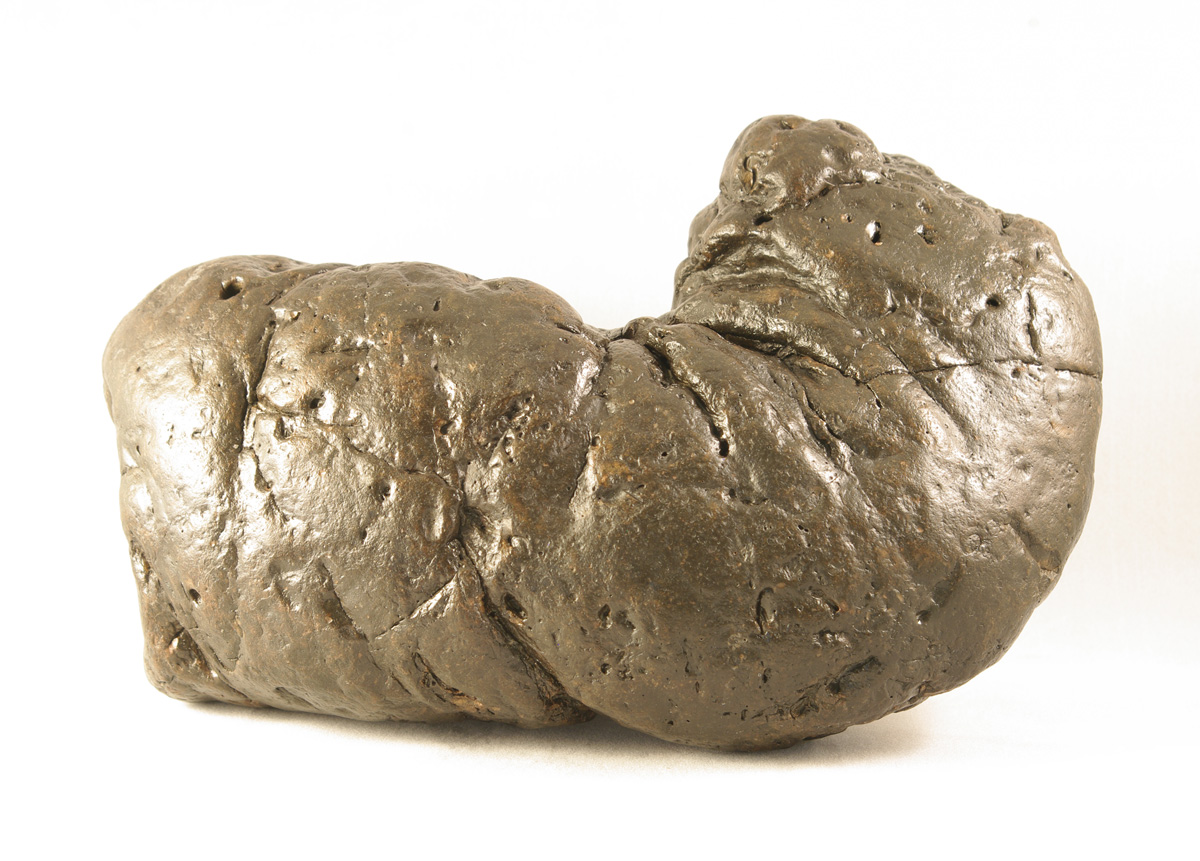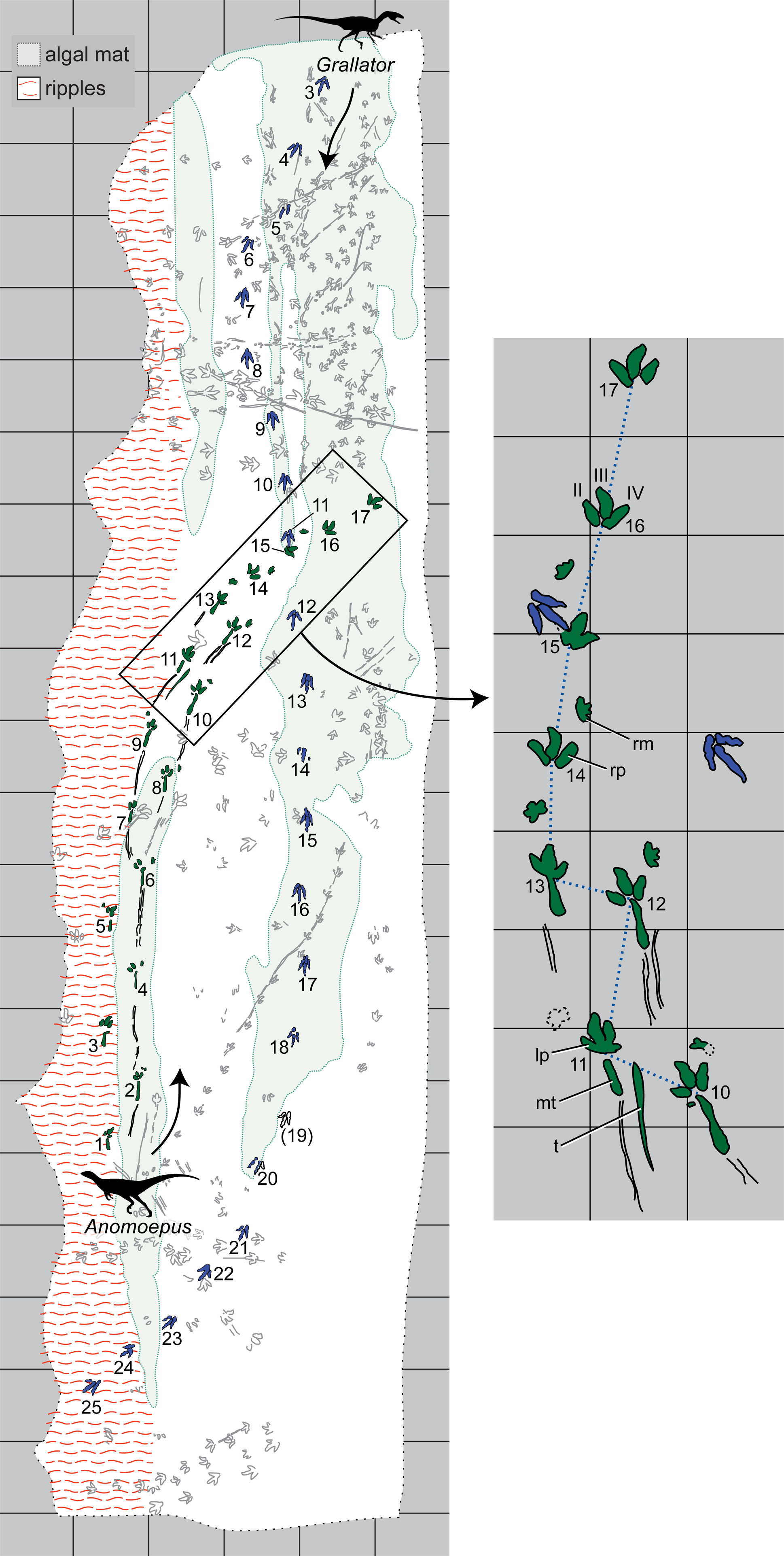|
Ichnofossil
A trace fossil, also called an ichnofossil (; ), is a fossil record of biological activity by lifeforms, but not the preserved remains of the organism itself. Trace fossils contrast with body fossils, which are the fossilized remains of parts of organisms' bodies, usually altered by later chemical activity or by mineralization. The study of such trace fossils is ichnology - the work of ichnologists. Trace fossils may consist of physical impressions made on or in the substrate by an organism. For example, burrows, borings ( bioerosion), urolites (erosion caused by evacuation of liquid wastes), footprints, feeding marks, and root cavities may all be trace fossils. The term in its broadest sense also includes the remains of other organic material produced by an organism; for example coprolites (fossilized droppings) or chemical markers (sedimentological structures produced by biological means; for example, the formation of stromatolites). However, most sedimentary struc ... [...More Info...] [...Related Items...] OR: [Wikipedia] [Google] [Baidu] |
Ichnotaxa
An ichnotaxon (plural ichnotaxa) is "a taxon based on the fossilized work of an organism", i.e. the non-human equivalent of an artifact. ''Ichnotaxon'' comes from the Ancient Greek (''íchnos'') meaning "track" and English , itself derived from Ancient Greek (''táxis'') meaning "ordering".Definition o'ichno'at dictionary.com. Ichnotaxa are names used to identify and distinguish morphologically distinctive ichnofossils, more commonly known as trace fossils (fossil records of lifeforms' movement, rather than of the lifeforms themselves). They are assigned genus and species ranks by ichnologists, much like organisms in Linnaean taxonomy. These are known as ichnogenera and ichnospecies, respectively. "Ichnogenus" and "ichnospecies" are commonly abbreviated as "igen." and "isp.". The binomial names of ichnospecies and their genera are to be written in italics. Most researchers classify trace fossils only as far as the ichnogenus rank, based upon trace fossils that resemble eac ... [...More Info...] [...Related Items...] OR: [Wikipedia] [Google] [Baidu] |
Cambrian
The Cambrian ( ) is the first geological period of the Paleozoic Era, and the Phanerozoic Eon. The Cambrian lasted 51.95 million years from the end of the preceding Ediacaran period 538.8 Ma (million years ago) to the beginning of the Ordovician Period 486.85 Ma. Most of the continents lay in the southern hemisphere surrounded by the vast Panthalassa Ocean. The assembly of Gondwana during the Ediacaran and early Cambrian led to the development of new convergent plate boundaries and continental-margin arc magmatism along its margins that helped drive up global temperatures. Laurentia lay across the equator, separated from Gondwana by the opening Iapetus Ocean. The Cambrian marked a profound change in life on Earth; prior to the Period, the majority of living organisms were small, unicellular and poorly preserved. Complex, multicellular organisms gradually became more common during the Ediacaran, but it was not until the Cambrian that fossil diversity seems to rapidly ... [...More Info...] [...Related Items...] OR: [Wikipedia] [Google] [Baidu] |
Fossil
A fossil (from Classical Latin , ) is any preserved remains, impression, or trace of any once-living thing from a past geological age. Examples include bones, shells, exoskeletons, stone imprints of animals or microbes, objects preserved in amber, hair, petrified wood and DNA remnants. The totality of fossils is known as the ''fossil record''. Though the fossil record is incomplete, numerous studies have demonstrated that there is enough information available to give a good understanding of the pattern of diversification of life on Earth. In addition, the record can predict and fill gaps such as the discovery of '' Tiktaalik'' in the arctic of Canada. Paleontology includes the study of fossils: their age, method of formation, and evolutionary significance. Specimens are sometimes considered to be fossils if they are over 10,000 years old. The oldest fossils are around 3.48 billion years to 4.1 billion years old. Early edition, published online before prin ... [...More Info...] [...Related Items...] OR: [Wikipedia] [Google] [Baidu] |
Trace Fossil Classification
Trace fossils are classified in various ways for different purposes. Traces can be classified taxonomically (by morphology), ethologically (by behavior), and toponomically, that is, according to their relationship to the surrounding sedimentary layers. Except in the rare cases where the original maker of a trace fossil can be identified with confidence, phylogenetic classification of trace fossils is an unreasonable proposition. Taxonomic classification The taxonomic classification of trace fossils parallels the taxonomic classification of organisms under the International Code of Zoological Nomenclature. In trace fossil nomenclature a Latin binomial name is used, just as in animal and plant taxonomy, with a genus and specific epithet. However, the binomial names are not linked to an organism, but rather just a trace fossil. This is due to the rarity of association between a trace fossil and a specific organism or group of organisms. Trace fossils are therefore included in an ... [...More Info...] [...Related Items...] OR: [Wikipedia] [Google] [Baidu] |
Coprolite
A coprolite (also known as a coprolith) is fossilized feces. Coprolites are classified as trace fossils as opposed to body fossils, as they give evidence for the animal's behaviour (in this case, diet) rather than morphology. The name is derived from the Greek words κόπρος (''kopros'', meaning "dung") and λίθος (''lithos'', meaning "stone"). They were first described by William Buckland in 1829. Before this, they were known as "fossil fir cones" and "bezoar stones". They serve a valuable purpose in paleontology because they provide direct evidence of the predation and diet of extinct organisms. Coprolites may range in size from a few millimetres to over 60 centimetres. Coprolites, distinct from '' paleofeces'', are fossilized animal dung. Like other fossils, coprolites have had much of their original composition replaced by mineral deposits such as silicates and calcium carbonates. Paleofeces, on the other hand, retain much of their original organic compo ... [...More Info...] [...Related Items...] OR: [Wikipedia] [Google] [Baidu] |
Coprolite With Distinct Vertebrate Bite Marks
A coprolite (also known as a coprolith) is fossilized feces. Coprolites are classified as trace fossils as opposed to body fossils, as they give evidence for the animal's behaviour (in this case, diet) rather than morphology. The name is derived from the Greek words κόπρος (''kopros'', meaning "dung") and λίθος (''lithos'', meaning "stone"). They were first described by William Buckland in 1829. Before this, they were known as "fossil fir cones" and "bezoar stones". They serve a valuable purpose in paleontology because they provide direct evidence of the predation and diet of extinct organisms. Coprolites may range in size from a few millimetres to over 60 centimetres. Coprolites, distinct from ''paleofeces'', are fossilized animal dung. Like other fossils, coprolites have had much of their original composition replaced by mineral deposits such as silicates and calcium carbonates. Paleofeces, on the other hand, retain much of their original organic compositio ... [...More Info...] [...Related Items...] OR: [Wikipedia] [Google] [Baidu] |
Cheirotherium Prints Possibly Ticinosuchus
''Chirotherium'', also known as ''Cheirotherium'' (‘hand-beast’), is a Triassic trace fossil consisting of five-fingered (pentadactyle) footprints and whole tracks. These look, by coincidence, remarkably like the hands of apes and bears, with the outermost toe having evolved to extend out to the side like a thumb, although probably only functioning to provide a firmer grip in mud. ''Chirotherium'' tracks were first found in 1834 in Lower Triassic sandstone (Buntsandstein) in Thuringia, Germany, dating from about 243 million years ago (mya (unit), mya). The creatures who made the footprints and tracks were probably pseudosuchian archosaurs related to the ancestors of the crocodiles. They likely belonged to either prestosuchidae or rauisuchidae groups, which were both large carnivores with semi-erect gaits. History ''Chirotherium'' tracks were first found in German Triassic sandstones in 1834, and later in England in 1838. They were found before dinosaurs were known and init ... [...More Info...] [...Related Items...] OR: [Wikipedia] [Google] [Baidu] |
Holocene
The Holocene () is the current geologic time scale, geological epoch, beginning approximately 11,700 years ago. It follows the Last Glacial Period, which concluded with the Holocene glacial retreat. The Holocene and the preceding Pleistocene together form the Quaternary period. The Holocene is an interglacial period within the ongoing Ice age, glacial cycles of the Quaternary, and is equivalent to Marine isotope stages, Marine Isotope Stage 1. The Holocene correlates with the last maximum axial tilt towards the Sun of the Earth#Axial tilt and seasons, Earth's obliquity. The Holocene corresponds with the rapid proliferation, growth, and impacts of the human species worldwide, including Recorded history, all of its written history, technological revolutions, development of major civilizations, and overall significant transition towards urban culture, urban living in the present. The human impact on modern-era Earth and its ecosystems may be considered of global significance for th ... [...More Info...] [...Related Items...] OR: [Wikipedia] [Google] [Baidu] |
Triassic
The Triassic ( ; sometimes symbolized 🝈) is a geologic period and system which spans 50.5 million years from the end of the Permian Period 251.902 million years ago ( Mya), to the beginning of the Jurassic Period 201.4 Mya. The Triassic is the first and shortest period of the Mesozoic Era and the seventh period of the Phanerozoic Eon. Both the start and end of the period are marked by major extinction events. The Triassic Period is subdivided into three epochs: Early Triassic, Middle Triassic and Late Triassic. The Triassic began in the wake of the Permian–Triassic extinction event, which left the Earth's biosphere impoverished; it was well into the middle of the Triassic before life recovered its former diversity. Three categories of organisms can be distinguished in the Triassic record: survivors from the extinction event, new groups that flourished briefly, and other new groups that went on to dominate the Mesozoic Era. Reptiles, especially archosaurs, were the ... [...More Info...] [...Related Items...] OR: [Wikipedia] [Google] [Baidu] |
Anomoepus
''Anomoepus'' is the name assigned to several fossil footprints first reported from Early Jurassic beds of the Connecticut River Valley, Massachusetts, US in 1802. All four feet have left impressions. The smaller forefeet have five toes, whereas the larger hind feet have three toes. There is also an impression which might indicate where the creature rested. The footprints were discovered, amongst others, by a farm boy, Pliny Moody. E.B. Hitchcock, a clergyman, described the ''Anomoepus'' footprints and others as evidence of ancient birds. They have since been identified as belonging to a dinosaur, probably an ornithischian, as indicated by the number of toes and the absence of claws on the rear digits. Trackways assigned to ''Anomoepus'' from Western Australia, Poland and Czech Republic have also been described. ''Anomoepus'' is the name of the footprint, not of the dinosaur, the identity of which remains unknown. Ichnospecies *'' A. scambus'' Hitchcock, 1848 *'' A. ranivorus ... [...More Info...] [...Related Items...] OR: [Wikipedia] [Google] [Baidu] |
Atreipus
''Atreipus'' is an ichnogenus or trace fossil attributed to early Ornithischian dinosaurs. Its significance for Triassic biostratigraphy has earned it some fame. Reptile footprint faunules from the early Mesozoic Newark Supergroup of eastern North America. See also * Ichnology A trace fossil, also called an ichnofossil (; ), is a fossil record of biological activity by lifeforms, but not the preserved remains of the organism itself. Trace fossils contrast with body fossils, which are the fossilized remains of part ... References {{trace-fossil-stub Ichnotaxa ... [...More Info...] [...Related Items...] OR: [Wikipedia] [Google] [Baidu] |







